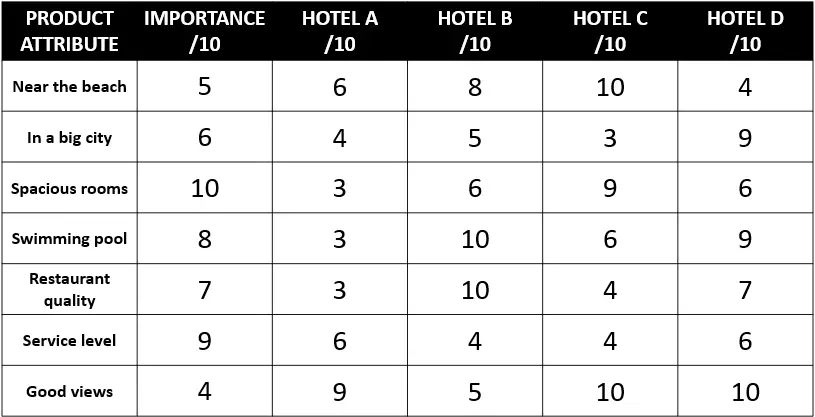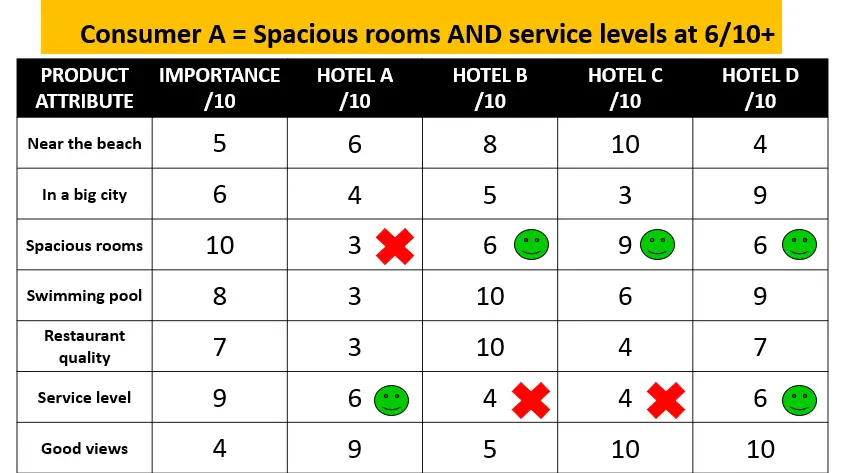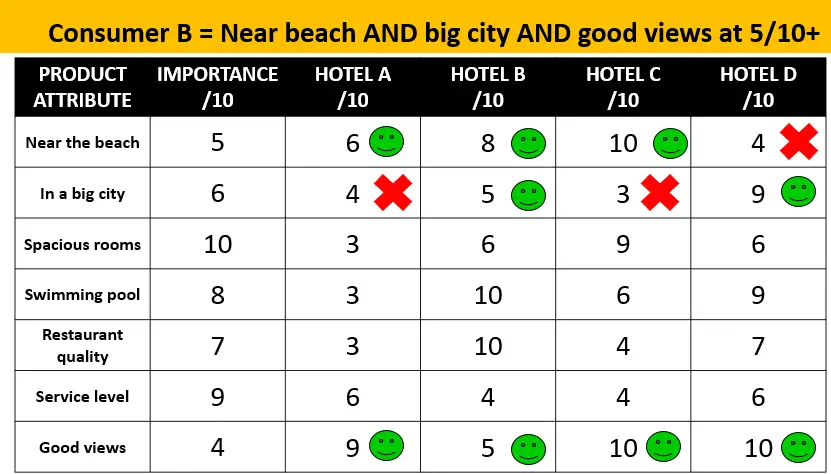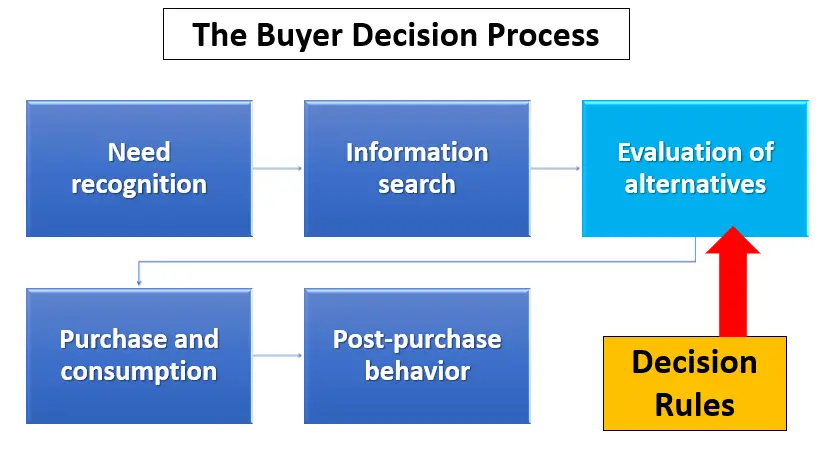Contents
What is the Conjunctive Decision Rule in Consumer Behavior?
Covered in this post:
- Overview of the Conjunctive Decision Rule
- A Detailed Example of the Conjunctive Decision Rule
- Two Video Summaries of the Conjunctive Rule and an Overview of all Decision Rules
- The Main Types of Decision Rules Used by Consumers
- Where Decision Rules Fit into Consumer Behavior
Overview of the Conjunctive Decision Rule
The conjunctive decision rule is a non-compensatory approach to decision-making.
When using the conjunctive decision rule, consumers will seek a combination of select product attributes which all must meet a minimum score (or a certain standard of performance in the consumer’s assessment).
For example, a consumer looking for a Smart TV may seek the combined product attributes of
- a large screen size AND
- good picture quality AND
- great sound quality
In this example, you should note that the word AND is in capitals, which is deliberate to indicate that the consumer is seeking all three of these product attributes to meet or exceed their expectations.
Any products considered that fail (that is, do not meet minimum expectations) on a ANY one of these attributes in the perception of the consumer – will be eliminated from choice and not considered a suitable selection.
Please note that there are multiple decision rules used by consumers, and some consumers may use more than one rule during the same decision to reach a final purchase choice. Often, the conjunctive decision rule is used to short-list a large set of competing brands.
Here is a video explaining the conjunctive decision rule, or scroll down for a worked example of the conjunctive approach in action.
A Detailed Example of the Conjunctive Decision Rule
Here is a scoring model for choosing a hotel for a holiday. As you can see there are four hotels in this comparison.
In the first column, there are a series of product attributes listed. When using the conjunctive rule, consumers will typically construct a short-listed of these attributes. This is generally done on how important each attribute is to them – for what combination of attributes they are seeking in the product.
In the second column, there is a score of overall importance for each product attribute, which has been scored out of 10 points. This means that the higher the number the better the perceived quality in the mind of the consumer.
In the next columns, we have the rating of each potential hotel choice for each attribute – again being scored out of 10 points – and again based on the consumer’s perception.
Note: In many cases consumers do NOT allocate a score to each attribute when making a decision. Instead, they will use a more qualitative scale such as – great, good, okay, poor, and so on. However, scores have been presented in this table in order to clearly understand the approach of the conjunctive decision rule.
When using the conjunctive decision rule, a consumer will need to select at least two or more attributes and to assess what level of quality/performance is needed in each of those attributes.
Let’s use two examples:
- Consumer A wants a score of 6/10 or more for: Spacious rooms AND service levels
- Consumer B wants a score of 5/10 or more for: Near the beach AND in a big city AND good views
In this case, Consumer A will choose HOTEL D. As shown below, it is the only hotel that scores 6/10 or more for ALL the attributes that they are seeking.
But Consumer B, who has selected three different product attributes and has set a minimum expectation of just 5/10, will choose HOTEL B as that is the only choice that meets their required combination of attributes and scores, as shown below.
Therefore, although these two consumers have used the same decision rule – in this case the conjunctive rule – they have tailored it to their own needs, which has resulted in a different purchase selection. This would be common, because most consumers will have unique needs and requirements.
However, it should be noted that one of the concerns of both the conjunctive and disjunctive decision rules is that you may end up with two or more suitable products to choose from at the end of evaluating the choices. In this case, the consumer would need to raise their expectations/scores, or adopt another decision rule to make a final decision
What are the Main Types of Decision Rules Used by Consumers
The main decision rules that are covered in most consumer behavior textbooks are placed into two broad groups, namely:
- Compensatory decision-making and
- Non-compensatory decision rules, which include:
- conjunctive,
- disjunctive,
- elimination-by-aspects,
- lexicographic, and
- affect referral
Compensatory decision rules are those that consider all the product attributes with the overall value of the product in combination being considered. The name “compensatory” comes from the fact that strong product attributes are able to offset (or compensate for) weaker product attributes in the customer’s assessment.
Non-compensatory decision rules are those where the consumer is focused upon a smaller set of product attributes, or they are seeking a particular combination of product attributes. In this case, weak product attributes are likely to rule out the product from further consideration in the decision, regardless of the product’s overall quality and set of attributes.
The following video provides a brief overview of each of these decision rules.
Where Do Decision Rules Fit into Consumer Behavior
Decision rules are used by consumers in the evaluation of alternatives stage of the buyer decision process – as shown in the following diagram. At this point in the process, they have gathered information and now must make a selection from competing alternatives.




